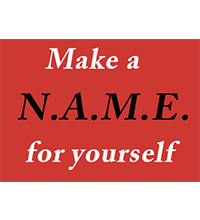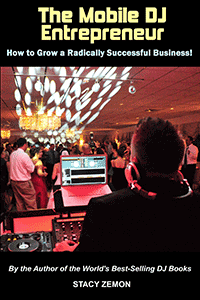Guest Article by Brian Durio
Attention! You have been magically transported back to English class with Dr. Proof, the grammar hawk of the DJ business.
Dr. Proof’s Grammar Goof #1: “setup” or “set up”?
This one is easy if you think about what you’re saying.
“Setup” is a noun. That DJ has a clean, neat setup.
“Set up” is a verb. I set up my gear and then changed clothes.
Dr. Proof’s Grammar Goof #2: “than” or “then”?
I see a whole lot of this mistake lately, but this one is easy, also.
“Than” is used when you’re comparing things. I think higher bit rates sound better than lower bit rates.
“Then” is used as a time reference. I played background jazz, then switched to high-energy standards.
People tend to write then instead of than because they tend to pronounce them the same way, but they do mean two entirely different things.
Dr. Proof’s Grammar Goof #3: “could” or “couldn’t” care less?
I see this one all the time in a lot of places: “I could care less.”
Now think about it. You’re saying that you do care to some degree and there’s room for you to care even less. If you could care less, then why don’t you?
What you mean is that you could not care less, right? Then you need to use its contraction: “I couldn’t care less.”
Dr. Proof’s Grammar Goof #4: Don’t use quotation marks for emphasis!
We all have seen what would seem to be out-of-place quotation marks around words on signs, flyers, menus, and the like.
Many people laugh at these “emphasis quotes,” because, when read in the ordinary way, they indicate that the word in quotes is not to be taken literally. Just how old is that “fresh” fish, anyway? Is there some hidden cost in that “free” coffee? “Guaranteed,” you say? Where’s the fine print?
Quotation marks are for just that, quoting something or somebody.
If you want to emphasize certain words or phrases, CAPITALIZE them, or use italics or boldface or underlining.
Dr. Proof’s Grammar Goof #5: its or it’s?
This is another error I see all over the place, but it’s easy to avoid if you think of its meaning (pun intended)!
Just remember two points and you’ll never make this mistake again.
1) “it’s” is a contraction meaning “it is” or “it has” and nothing else.
2) Try changing the “its” in your sentence to “his” and if it doesn’t make sense, then go with “it’s”. If it does make sense, you’ve got the right word.
Simple enough? No? Please reread the above until it becomes second nature!
Dr. Proof’s Grammar Goof #6: Commas, Part 1
This will be the Cheat Sheet for comma usage and is by no means an exhaustive tutorial.
The first thing to remember is that the comma often marks a natural pause in the flow of a sentence, and it separates one phrase from another. If you write “I plan to see Shirl and Fred will go shopping while we visit” your readers are naturally going to think the visit will be with both Shirl and Fred until the second half surprises them when they realize that Fred isn’t involved in this visit at all. A simple comma makes everything clear: “I plan to see Shirl, and Fred will go shopping while we visit.” The trouble with commas is that in spoken English, emphasis and rhythm mark out phrases. It takes a conscious effort to translate the rhythm of a sentence into writing using punctuation.
Commas often help set off interrupting matter within sentences. A mild interruption, which is the case most of the time, is nicely set off with commas. Other punctuation used in these cases are parentheses (which we all know), and for fairly strong interjections, dashes-if you know how to use them properly-work best. Many writers don’t realize that they’re setting off a phrase, so they use one comma but forget the second, which should conclude the offsetting word or phrase! For example, “The Best Man, Matt Boone proposed the first toast.”
A standard use for commas is in separating the items in a series: “cats, dogs, and birds.” There is a lot of debate as to whether that final comma before the “and” − called a “serial comma” − is required. I prefer putting the comma in because items in lists can easily be misunderstood and/or confused without one. It often removes ambiguities.
“Comma splices” are mistakenly used where clauses require some stronger punctuation. Here’s an example: “He brought her a dozen roses, he had forgotten she was allergic to them.” In this sentence there are two related but separated ideas, so something stronger, like a semicolon, is needed to break them up: “He brought her a dozen roses; he had forgotten she was allergic to them.” Or just use the conjunction “but”: “He brought her a dozen roses but he had forgotten she was allergic to them.” Here’s a worse example of a comma splice: “It was a beautiful day outside, she remembered in time to grab her coffee mug.” There is no obvious logical connection between the two parts of this sentence, and they don’t belong in the same sentence at all! It should be, “It was a beautiful day outside. She remembered in time to grab her coffee mug.”
Some writers use commas seemingly at random: “The old amp, was used mainly as backup.” When you’re not certain a comma is required, read your sentence aloud. If it doesn’t seem natural to insert a slight pause or hesitation at the point marked by the comma, it probably shouldn’t be there.
Dr. Proof’s Grammar Goof #7: Me, Myself, and I
Many people have trouble deciding when to use me, myself, or I in a sentence. Can you tell which of the examples below is correct?
a. Kelly and me are barbecuing pork for the party.
b. Do you want Jen and I to plan the event?
c. If you have questions, please contact Horatio or myself.
Simply take out the other part of the phrase and see if it still makes sense.
a. Me am barbecuing pork for the party.
b. Do you want I to plan the event?
c. If you have questions, please contact myself.
As you can easily see, the italicized words are incorrect; therefore, the sentences should be as follows.
a. Kelly and I are barbecuing pork for the party.
b. Do you want Jen and me to plan the event?
c. If you have questions, please contact Horatio or me.
Dr. Proof’s Grammar Goof #8: Can I Quote You on That?
Providing quotes can make your writing more interesting to read, more clear and concise, and more relevant to your reader. If a picture is worth a thousand words, an appropriate quote can be worth just as many.
There are many ways to add quotes to a sentence. One of the most common, including a quote at the end of a sentence, requires just a bit of know-how.
Punctuation for Quotes that End a Sentence
There are two steps to follow to correctly punctuate a quote that ends a sentence. First, select the punctuation, and then place it with the corresponding part of the sentence.
Selecting the punctuation can be tricky at first. Do you use the punctuation from the quote or the punctuation from your sentence?
End the sentence with the strongest mark.
- Exclamation point
- Question mark
- Period
After you know which mark to use, it’s easy to determine where to place the punctuation – inside or outside the quotation marks. Keep the punctuation with its part of the sentence. If the punctuation belongs to the quoted material, include the punctuation inside your quote marks. If the punctuation belongs to your sentence, close the quote and then punctuate.
Correct Examples
Did you hear Eric say that “the Huskies are the BEST college football team!”
- The sentence is asking a question; the quote is an exclamation.
- Use the exclamation point as it is stronger in tone than a question.
- Keep the exclamation point inside the quotes because it is part of what is being quoted.
Do you agree that “the sky is blue”?
- The sentence is asking a question; the quote is a statement that would normally end with a period.
- Use the question mark because the question of the sentence is stronger than the statement being quoted.
- Place the mark outside the quotes as it is not part of the quote.
Which reports do I need to ask for when the customer asks me “what can we do to reconcile the issue?”
- The main sentence is a question, and the quote is a question.
- Use a question mark because it’s your only option!
- Keep the punctuation inside the quotes. When the sentence and the quote use the same punctuation, the punctuation goes inside the quotes.
Dr. Proof’s Grammar Goof #9: You’d like to what? On behalf of whom?
This happens a lot: DJs welcome guests to an event by saying, “On behalf of myself and ABC Hall, I’d like to welcome you to …” There are a couple of problems here.
First, you can’t do anything on behalf of yourself. You’re doing something as the agent of or on someone’s part. Second, if you’d like to do something, why don’t you go ahead and do it?
So it should be, “On behalf of ABC Hall, I welcome you to …”
Dr. Proof’s Grammar Goof #10: There, their, or they’re?
These three little words can be challenging because they are perfect homophones, so they are pronounced exactly the same, yet the rules for writing them are all too easy to forget. How can we tell them apart?
The Short Answer
There refers to a place.
Their indicates possession.
They’re is a contraction of the words they and are.
Correct Examples
There is a huge bowl of cookies at John and Tiffany’s house.
They’re supposed to be home in the evening.
We went to their house to score some cookies.
Test Yourself
If you use there, will your sentence still work if you replace it with here?
If you use their, will your sentence still work if you replace it with our or my?
If you use they’re, will your sentence still work if you replace it with they are?
Where Good People Go Wrong
People are most often confused by their and they’re. The problem is that apostrophes are used both to form possessives and create contractions, so it’s very tempting to use an apostrophe when writing that something is theirs. Don’t fall for it. Never use an apostrophe for possessive pronouns.
Bonus Tip
Its and it’s follow the same rule as their and they’re. Its is the possessive form, and it’s is a contraction.
Dr. Proof’s Grammar Goof Lagniappe: Masters of what?
An MC is a Master of Ceremonies. It’s one person who presides over the ceremonies being held. If there is more than one MC, they are Masters of Ceremonies, not Masters of Ceremony. Ceremonies are still being held, so that word remains plural.






